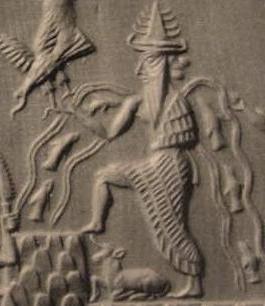A couple of disparate things to talk about this week: continuing the tour of the Zodiac constellations with Aquarius, a challenge to myself to photo some open star clusters, and a pre-dawn occultation of a prominent star. So let’s get to it!

Enki as Aquarius, from the Adda Seal in the British Museum, circa 2300 BC. Note the goat at his feet and the fish in the water pouring from his shoulders.
Does everybody remember Enki? Also known as Ea? Oannes, maybe? As I delved into the story of Capricornus about six weeks ago, I discovered that Enki was the creator-god of ancient Sumer, in addition to being the god of wisdom, fertility, creativity… and water. He was often pictured with a jug of water, or with water pouring out of his shoulders. Ea/Oannes were Babylonian versions of this same deity, with the added twist that his waters could be both life-giving and destructive, and were responsible for the annual flooding of rivers. Enki/Ea/Oannes were all immortalized in the stars, both as the water-bearer Aquarius, and his fish-goat symbolic conflation, Capricornus.
The ancient Egyptians must have known about Enki. Much of the lore of Egyptian astronomy seems to have been home-grown, but the constellation we now call Aquarius was associated with the annual flooding of the river Nile – later in the spring when Aquarius’s jar is dipped to the surface. The old Babylonian stories persisted.

Aquarius. Screenshot from Stellarium.
Even in the first century AD, when the Greek philosopher Ptolemy gave us our “modern” renditions of many constellations, he knew what Aquarius was – but in the Greek legend, the water-bearer was actually Ganymede, servant to the Gods of Olympus. The figure, however, remained essentially unchanged. Like Capricornus, our human interpretation of this constellation has remained fairly consistent for thousands of years.
Aquarius is not a prominent asterism. Fomalhaut, which I discussed a couple weeks ago, in Piscis Austrinis, is the brightest star in the area, and sits beneath Aquarius’s feet. A diagonal drawn through the square of nearby Pegasus (westward from Andromeda) barely clears his head. In between, Aquarius occupies a dark swath of sky, easily overlooked in a time of year when the Milky Way is still arcing prominently overhead.

Aquarius and Pegasus, via Stellarium
Speaking of the Milky Way, I picked up this week on a good target for unaided DLSR photography, and then realized that I’d unintentionally already captured it. The Double  Cluster, in Perseus, is a naked-eye visible bright patch in the northern Milky Way, near Cassiopeia. Just after dark, look below the sideways “W”, and you’ll spot a fuzzy patch, perhaps dim enough that you can only see it by looking slightly to one side. This is my target this week – and for others out there who are practicing at capturing deep objects without a telescope, I invite you to give it a try, and share what you find.
Cluster, in Perseus, is a naked-eye visible bright patch in the northern Milky Way, near Cassiopeia. Just after dark, look below the sideways “W”, and you’ll spot a fuzzy patch, perhaps dim enough that you can only see it by looking slightly to one side. This is my target this week – and for others out there who are practicing at capturing deep objects without a telescope, I invite you to give it a try, and share what you find.
As I looked at this, I found a shot I took almost 6 months ago, with Cassiopeia low and almost lost in the glare of the horizon, with the Double Cluster above it. This time, I’ll be deliberate!

Cassiopeia, the Double Cluster, and part of Perseus. Randomly photographed in March, just aiming at a part of the Milky Way, back when the constellations were “upside down” compared to their October arrangement. Cassiopeia is in the glow at the bottom.
Finally, for those who enjoy occultations, there’s a good one in the pre-dawn hours next Sunday, Oct 15. The crescent Moon will be blocking Regulus, the bright star at the bottom of Leo’s sickle. You may remember that a couple of lunar cycles ago (not quite two months), the Moon was very near Regulus, but it was a New Moon, and the Sun happened to be in the mix as well. Well this certainly won’t be as dramatic as the solar eclipse, but think of it as a very tiny eclipse, or perhaps as watching an alien sunset. Also note how far Regulus and the Sun have moved apart in the last 7 weeks or so. The sky just keeps turning.
Regulus will disappear first behind the bright limb of the crescent, at about 5:30am for east coast viewers. A table of specific times (in UTC or Greenwich Mean Time) and locations can be found here – this really is just like an eclipse, in that the viewing area corresponds to the area where the Moon is casting a shadow on Earth. In this case that shadow is that of a very small distant point light source. Everybody in the US can see it, EXCEPT the west coast. The rotation of the planet will be such that the shadow “makes landfall”, if you will, from space to planet, at a point where the western deserts are just barely visible on the Earth’s disk – from a Moon and Regulus point of view. In other words, the pair will not yet have risen on the west coast when all this happens, and will still be below the horizon.
Anyway, the more interesting part may be when Regulus suddenly reappears on the dark limb of the Moon, a little more than an hour after it disappeared. Assuming the skies are still dark enough (nearing sunrise) to see Regulus, can you pinpoint the time and location it will suddenly pop back into view?
Enjoy watching the skies this week!
Get Out There
Troy
flying-squirrel.org





